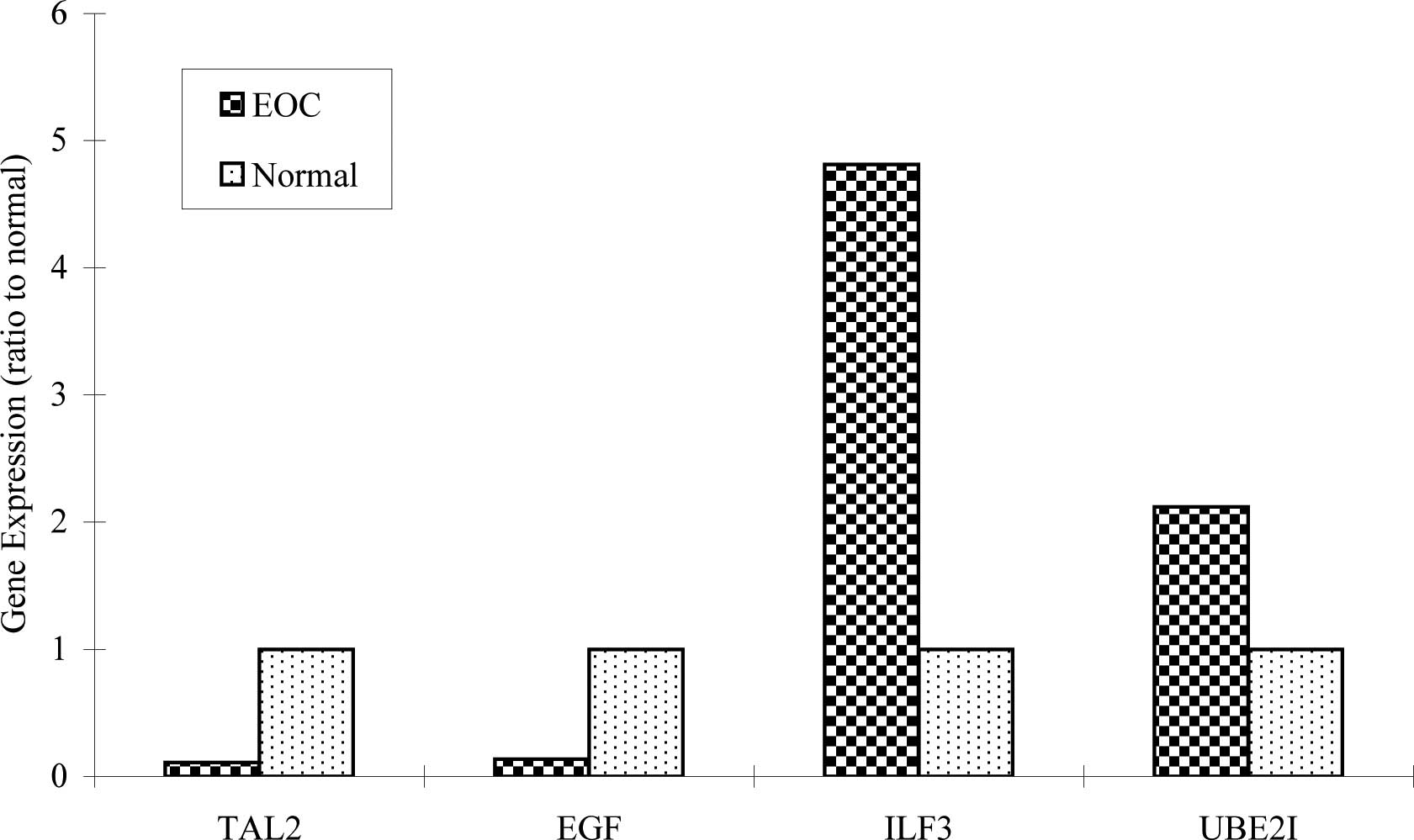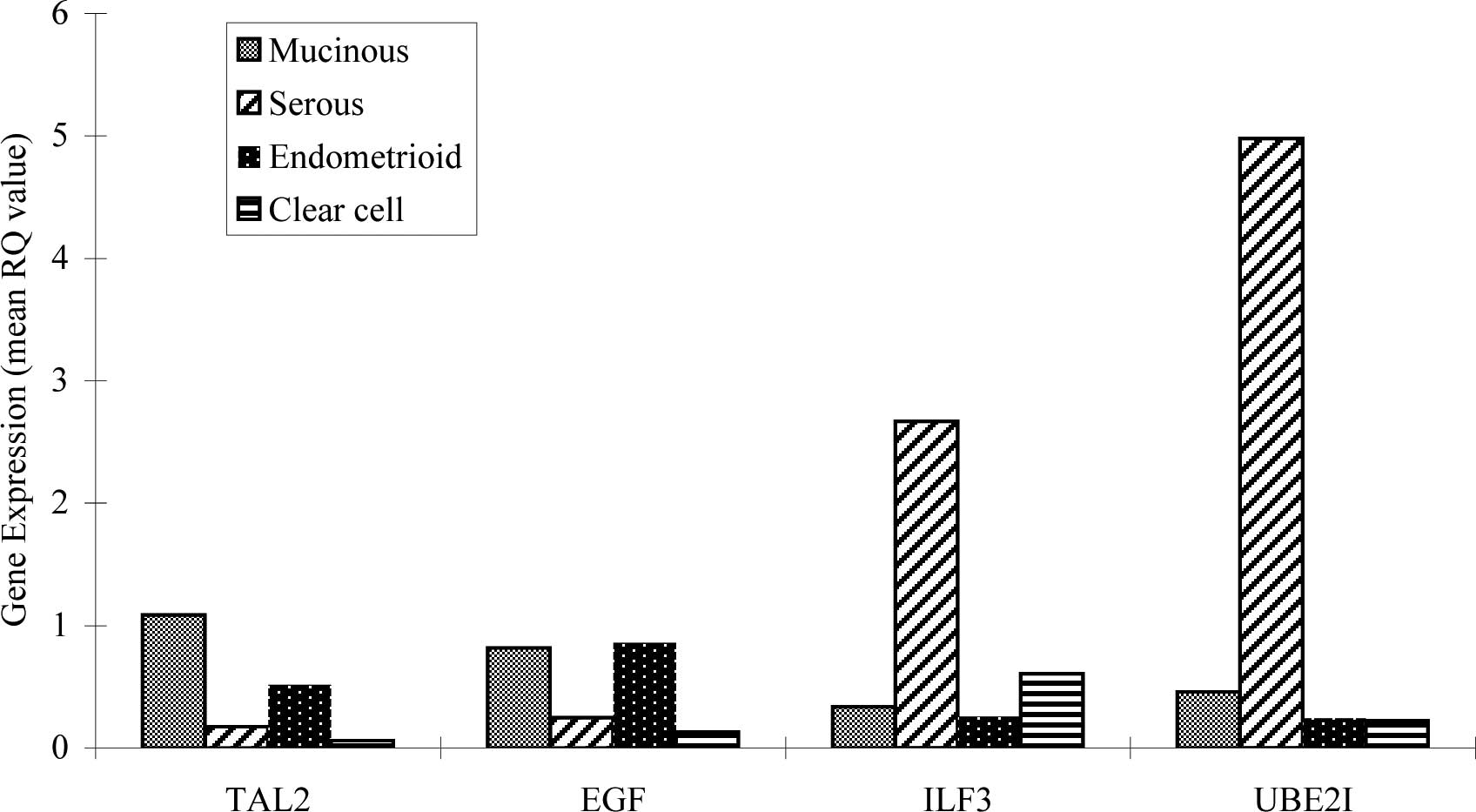|
1.
|
Shih IM and Kurman RJ: Ovarian
tumorigenesis. Am J Pathol. 164:1511–1518. 2004. View Article : Google Scholar
|
|
2.
|
Baranova A, Gowder S, Naouar S, et al:
Expression profile of ovarian tumors distinct signature of
Sertoli-Leydig cell tumor. Int J Gynecol Cancer. 16:1963–1972.
2006. View Article : Google Scholar : PubMed/NCBI
|
|
3.
|
Yu JJ: Unlocking the molecular mechanisms
of DNA repair and platinum drug resistance in cancer chemotherapy.
Curr Drug Ther. 4:19–28. 2009. View Article : Google Scholar
|
|
4.
|
Bell DA: Origins and molecular pathology
of ovarian cancer. Mod Pathol. 18:19–32. 2005. View Article : Google Scholar
|
|
5.
|
Cecco LD, Marchionni L, Gariboldi M, et
al: Gene expression profiling of advanced ovarian cancer
characterization of a molecular signature involving fibroblast
growth factor 2. Oncogene. 23:8171–8183. 2004. View Article : Google Scholar : PubMed/NCBI
|
|
6.
|
Tothill RW, Tinker AV, Joshy G, et al:
Novel molecular subtypes of serous and endometrioid ovarian cancer
linked to clinical outcome. Clin Cancer Res. 14:5198–5208. 2008.
View Article : Google Scholar : PubMed/NCBI
|
|
7.
|
Reed E, Yu JJ, Davies A, Gannon J and
Armentrout SL: Clear cell tumors have higher mRNA levels of ERCC1
and XPB than other histological types of epithelial ovarian cancer.
Clin Cancer Res. 9:5299–5305. 2003.PubMed/NCBI
|
|
8.
|
Schwartz DR, Kardia SLR, Shedden KA, et
al: Gene expression in ovarian cancer reflects both morphology and
biological behavior, distinguishing clear cell from other
poor-prognosis ovarian carcinomas. Cancer Res. 62:4722–4729.
2002.
|
|
9.
|
Fehrmann RS, Li XY, van Der Zee AG, de
Jong S, Te Meerman GJ, de Vries EG and Crijns AP: Profiling studies
in ovarian cancer: a review. The Oncologist. 12:960–966. 2007.
View Article : Google Scholar : PubMed/NCBI
|
|
10.
|
Yu JJ, Dabholkar M, Bennett WP, Welsh JA,
Mu CJ, Bostick-Bruton F and Reed E: Platinum-sensitive and
platinum-resistant ovarian cancer tissues show differences in the
relationships between mRNA levels of p53, ERCC1 and XPA. Int J
Oncol. 8:313–317. 1996.PubMed/NCBI
|
|
11.
|
Pinheiro P, Gering M and Patient R: The
basic helix-loop-helix transcription factor, TAL2, marks the
lateral floor plate of the spinal cord in zebrafish. Gene Expr
Patterns. 4:85–92. 2004. View Article : Google Scholar : PubMed/NCBI
|
|
12.
|
Bucher K, Sofroniew MV, Pannell R, et al:
The T cell oncogene Tal2 is necessary for normal development of the
mouse brain. Dev Biol. 227:533–544. 2000. View Article : Google Scholar : PubMed/NCBI
|
|
13.
|
Ferrando AA, Neuberg DS, Staunton J, et
al: Gene expression signatures define novel oncogenic pathways in T
cell acute lymphoblastic leukemia. Cancer Cell. 1:75–87. 2002.
View Article : Google Scholar : PubMed/NCBI
|
|
14.
|
Wong AST and Leung PCK: Role of endocrine
and growth factors on the ovarian surface epithelium. J Obstet
Gynaecol Res. 33:3–16. 2007. View Article : Google Scholar
|
|
15.
|
Ahmed N, Maines-Bandiera S, Quinn MA,
Unger WG, Dedhar S and Auersperg N: Molecular pathways regulating
EGF-induced epithelio-mesenchymal transition in human ovarian
surface epithelium. Am J Physiol Cell Physiol. 290:1532–1542. 2006.
View Article : Google Scholar : PubMed/NCBI
|
|
16.
|
Stromberg K, Johnson GR, O'Connor DM,
Sorensen CM, Gullick WJ and Kannan B: Frequent immunohistochemical
detection of EGF supergene family members in ovarian
carcinogenesis. Int J Gynecol Pathol. 13:342–347. 1994. View Article : Google Scholar : PubMed/NCBI
|
|
17.
|
Niikura H, Sasano H, Sato Sh and Yajima A:
Expression of epidermal growth factor-related proteins and
epidermal growth factor receptor in common epithelial ovarian
tumors. Int J Gynecol Pathol. 16:60–68. 1997. View Article : Google Scholar : PubMed/NCBI
|
|
18.
|
Cazanove O, Batut J, Scarlett G, et al:
Methylation of XILF3 by Xprmt1b alters its DNA, but not RNA,
binding activity. Biochemistry. 47:8350–8357. 2008. View Article : Google Scholar : PubMed/NCBI
|
|
19.
|
Saunders LR and Barber GN: The dsRNA
binding protein family: critical roles, diverse cellular functions.
FASEB J. 17:961–983. 2003. View Article : Google Scholar : PubMed/NCBI
|
|
20.
|
Vumbaca F, Phoenix KN, Rodriguez-Pinto D,
Han DK and Claffey KP: Double-stranded RNA-binding protein
regulates vascular endothelial growth factor mRNA stability,
translation and breast cancer angiogenesis. Mol Cell Biol.
28:772–783. 2008. View Article : Google Scholar
|
|
21.
|
Schumacher JJ, Dings RPM, Cosin J,
Subramanian IV, Auersperg N and Ramakrishnan S: Modulation of
angiogenic phenotype alters tumorigenicity in rat ovarian
epithelial cells. Cancer Res. 67:3683–3690. 2007. View Article : Google Scholar : PubMed/NCBI
|
|
22.
|
Bermudez Y, Yang H, Saunders BO, Cheng JQ,
Nicosia SV and Kruk PA: VEGF- and LPA-induced telomerase in human
ovarian cancer cells is Sp1-dependent. Gynecol Oncol. 106:526–537.
2007. View Article : Google Scholar : PubMed/NCBI
|
|
23.
|
Moschos SJ and Mo YY: Role of SUMO/Ubc9 in
DNA damage repair and tumorigenesis. J Mol Hist. 37:309–319. 2006.
View Article : Google Scholar : PubMed/NCBI
|
|
24.
|
Mo YY, Yu Y, Theodosiou E, Ee PL and Beck
WT: A role for Ubc9 in tumorigenesis. Oncogene. 24:2677–2683. 2005.
View Article : Google Scholar : PubMed/NCBI
|
|
25.
|
Dűnnebier T, Bermejo JL, Haas S, et al:
Common variants in the UBC9 gene encoding the SUMO-conjugating
enzyme are associated with breast tumor grade. Int J Cancer.
125:596–602. 2009.
|
















